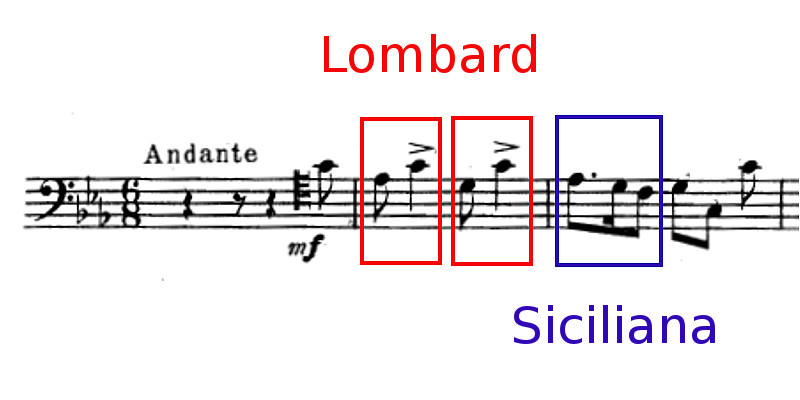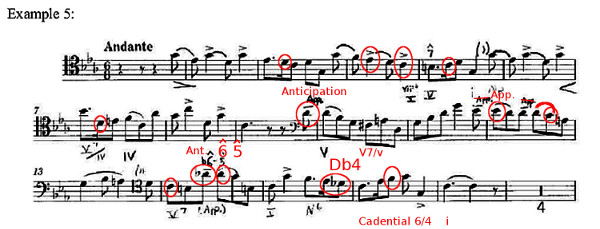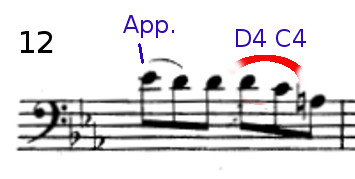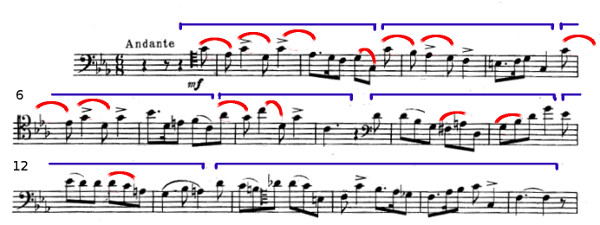Carl Maria von Weber.
https://en.wikipedia.org/wiki/Carl_Maria_von_Weber
I mentioned in the prior video some of the Hungarian rhythmic aspects of the Rondo. The Hungarian aspects expressed in the Andante are quite different. The Lombard rhythm, short-long, starts the melody in measure two and is repeated many times. Portions of this movement refer to the Siciliana, which is a 6/8 dance with the dotted eighth, sixteenth, and eighth note rhythm.

You can see that rhythm in measures three and five. Now, neither of these rhythmic devices are associated solely with the Hungarian or Gypsy idioms, however, they set the mood that this is a composition that departs from the typical Common Practice composition. The exoticism or “otherness” of the Andante is most persuasively conveyed by its insistence on rhythmic and dissonant stresses off the beat. Notice in the opening that Weber provides accents on the “off beats” of the Lombard rhythms. These rhythms are found in measures two and four and later in the composition. Furthermore the placement of dissonance often avoids strong metrical positions.
Let’s examine this more closely by studying the analysis by Dr. Melissa Kritzer on page 76 of her dissertation.

My markings are in red in Example 5.

Measure 12 provides a temporary reprieve and I give stresses on the beat here. There is a real appoggiatura on the downbeat and then I play the next beat with the same stresses and slurred articulation. Aside from the traditional use of dissonance in the Siciana rhythm and measure 12, it is important to convey the usual placements of these dissonances to the listener.
The Db4 in measure 15 (Example 5) is given over the chord of a Neapolitan Sixth. Technically this Db is a consonance with the Neapolitan Sixth. However, the note is so unusual and striking at that point in harmony that I have circled note again showing its emphasis on the offbeat. Although my analysis differs from Dr. Kritzer’s this in no way diminishes the fine research she has done. I concur with her observations that many of the dissonances are strategically placed off the beat in this theme to enhance the exotic and unexpected nature of this melody.

Weber presents hypermeter in this melody. Hypermeter is a combination of measures into a larger unit. The blue brackets indicate that two 6/8 measures are combined; the first measure with the Lombard and the second with Siciliana rhythms. Performing the melody (measures 1-13) with 12/8 measures instead of two 6/8 measures will enhance the expression. Thus, each two measures features a slight crescendo and decrescrendo with the climax occurring on the downbeat of the second measure. The pickup to measure 14 breaks with the previous pattern and is presented as a four measure phrase. I add the slurs in the figure to enhance the expression of the melody and also to provide more emphasis to the accents. Tonguing, rather than slurring into the accent, gives the note more emphasis. I tongue the downbeats in measures 7 and 9 to increase my accuracy on those notes. In measure 12 I slur from the appoggiatura downbeat and repeat the same gesture in the next beat from D4 to C4.
The low register articulation can be tricky in this movement.

It is even more of a problem in the Weber concerto.

The key to both is to use
the same air stream and embouchure for the articulated notes as one would use
for slurring the same notes. For example, in measure 28 let’s first practice
this section slurred.
I provide musical contrast in measures 39-55 much
as I did in the pickup in measure 9 continuing on to measure 13. Longer and more
lyrical notes are called for here. Notice that Weber did not include as many
accents, and in measure 50 the accents are more like expressive appoggiaturas
rather than unexpected exotic notes. Here is a portion of that passage.
Copyright (c) 2016 by Terry B. Ewell. All rights reserved.
